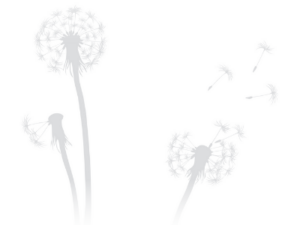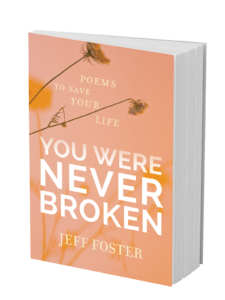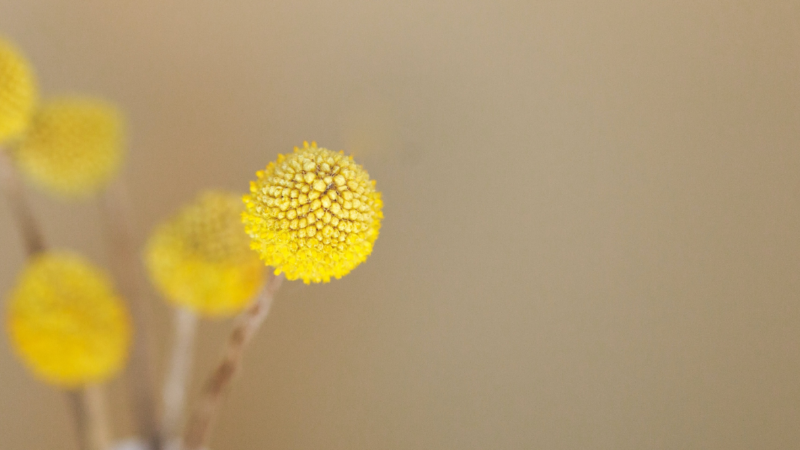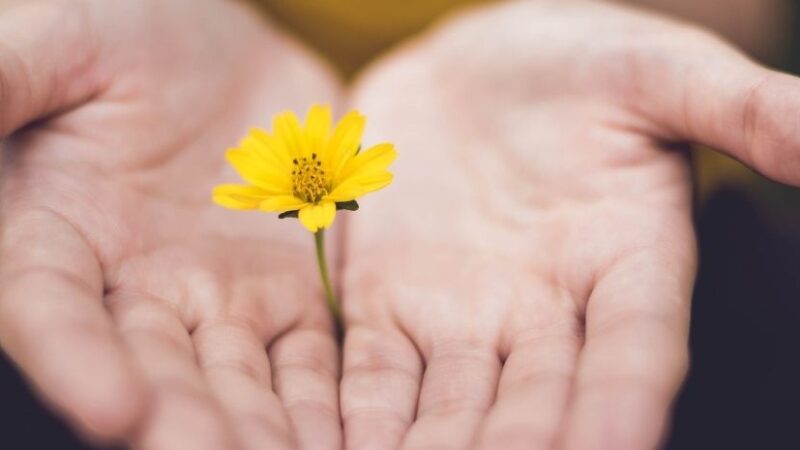Into the Belly of Meditation
Into the Belly of Meditation
By Jeff Foster
You are weary, friend.
Sit.
You are thirsty.
Here. Drink.
You are hungry. Here. Take this.
A piece of bread.
A small bowl of soup.
See how God has taken form!
It is all I have but it will keep you alive.

I will light a fire that will never go out.
A sacred flame. Unconditional in its burning.
To illuminate us in the darkness.
Oh. I see you are wounded.
Bruised. Bleeding.
Exhausted from the world.
You have suffered much, I know.

Come.
Take off these dirty rags.
Don’t worry. It’s safe.
There is strength in your nakedness.
Here. Wash.
Rub this medicine onto your wounds.
Put on these robes, they are clean and dry.
Lie down. Close your eyes.
I will watch over us tonight.

Listen. You have not failed.
I see new life breaking through.
I see birth. An insurrection.
The sharp edge of hope.
I have no teaching for you.
No wise words.
I only want you to trust what you are going through.
To bring this fire inside of you.
Until the end.
I have known this pain. Yes.
This courage to keep moving. Yes.
This courage to rest, too.
The sacrifice of the known world.

Friend.
Drop into the belly of meditation now.
The place you were always seeking.
The vast silence at the Earth’s core which is your own core.
Breathing into the gut now.
The throat. The chest.
Irradiating the nervous system with unspeakable
tenderness.
Flooding the body with soft, warm light.
Drenching the human form with divine love.
And sleep.
And sleep.

I may not be here when you wake.
We may not meet again in form.
Yet I leave you with all you need.
Food. Water. A bed.
A chance to rest.
A touch of kindness.
And your unbreakable Self.

This poem is excerpted from You Were Never Broken: Poems to Save Your Life by Jeff Foster.
 Jeff Foster shares from his own awakened experience a way out of seeking fulfillment in the future and into the acceptance of “all this, here and now.” He studied astrophysics at Cambridge University. Following a period of depression and physical illness, he embarked on an intensive spiritual search that came to an end with the discovery that life itself was what he had always been seeking.
Jeff Foster shares from his own awakened experience a way out of seeking fulfillment in the future and into the acceptance of “all this, here and now.” He studied astrophysics at Cambridge University. Following a period of depression and physical illness, he embarked on an intensive spiritual search that came to an end with the discovery that life itself was what he had always been seeking.

Learn More
Sounds True | Amazon | Barnes & Noble | Bookshop
3 Ways to be in Financial Integrity this Holiday Season
In the whirlwind of holiday parties, gift-giving, and cooking, you can lose your grip on financial integrity faster than slipping on ice. But, your integrity is essential to your happiness and your self-worth. Here are a few easy ways to regain your center and empower your choices to give from your heart instead of your wallet.
Treasure Connectivity
When your presence is truly a gift to others, you won’t find yourself needing to overspend. Practice loving presence with the little interactions you have through the day. Slow down. Listen more. Smile more. Appreciate the uniqueness of the person in front of you. When you treasure connectivity, you won’t find yourself spending money on things that aren’t in alignment with your values.
Affirm Your Unique Values & Convictions
Speaking of aligning to your values … what are YOUR values? What do you value about the holidays? About gifting? About receiving? About money? Take a minute and write down your values and your convictions about the holidays. Read your convictions before bed, and upon arising. You’ll be more likely to live up to your convictions with money. And when you don’t, you’ll be very clear exactly what value you violated. When that happens, stop. Notice. Course correct.
Gift from Your Values
Whether you’re baking cookies or filling stockings, make each an act in alignment with your convictions. At first you may be aware of how your extended family or friends have different trends, values, or convictions. That’s ok. Notice. And be YOU. Be in your integrity. Make your people paleo gingersnaps or whatever you find nourishing and delightful. Tell your people why you gift how you gift. They love you for being you. And you being you will help them find their own financial integrity.
 Cate Stillman has been teaching audiences how to create health and wellness through yoga and Ayurveda since 2001. She is the author of Body Thrive, and hosts the Yogahealer Real Thrive Show, a weekly podcast featuring dozens of experts in the field. She splits her time between the Idaho border country and Mexico.
Cate Stillman has been teaching audiences how to create health and wellness through yoga and Ayurveda since 2001. She is the author of Body Thrive, and hosts the Yogahealer Real Thrive Show, a weekly podcast featuring dozens of experts in the field. She splits her time between the Idaho border country and Mexico.
Yoga For Pain Relief

Yoga For Pain Relief
We often find metaphors for life in our yoga practice, and those of us who come to yoga stiff or weak are only too familiar with confronting our edges. In most urban, contemporary societies, we are frequently exposed to confrontation: in our communities, our relationships, our jobs—the list goes on. Our success in dealing with confrontation and the stress it generates depends on our ability to recognize and adjust to what presents itself in those situations. It is often easy to avoid dealing with confrontation until it reaches a certain level of intensity and we are forced to address what stands in our way.
The Hidden Gift of Obstacles in Yoga
When our tools for dealing with confrontation are overwhelmed and when what we perceive as our very nature becomes threatened, our life systems—mental, emotional, and physical—begin to contract. If we ignore this contraction for too long, it can color the way we perceive our reality, and what is very unnatural to a healthy body begins to seem natural. Because this process occurs over extended periods, as in the aging process, we often lack the awareness that it is happening until we are beyond simple fixes.
Difficult Poses
Consider the beginner’s approach to difficult poses—even the relatively simple ones—that challenge flexibility, balance, or strength. These poses take our attention directly into areas of our body that are unfamiliar, painful, or unresponsive. This is often confronting. Stiff people have to learn how to work with pain, which is often intense, in order to remove the obstructions found in tight muscles or joints. Typically, this work is associated with movement where previously no movement existed or where it was extremely limited. The weak or overly flexible have to learn how to work without overworking, to create the support or resistance necessary to bring about the subtle movement of energy in the body to build stamina or strength.
It is a common experience for beginners to question why they lack movement or feeling in these areas in the first place and to wonder if there will ever come a day when it could be different. This is the beauty of the confrontation found in yoga, where opposites attract and working simultaneously with effort and non-effort is a very important lesson to learn.
Overcoming Resistance In Yoga
With many of the asanas that a beginner tackles for the first time, it is common to struggle with the opposing forces of particular actions found in a pose. Attempting to relax tight muscles is not easy when we are receiving a steady stream (or scream) of more demanding messages in the seemingly undecipherable language of pain. It can feel like the very resistance we experience has been protecting us from injury or overdoing something and that to surrender into this discomfort would be unwise.
Likewise, working with weak muscles to stay in a pose, to dig a little deeper, even for one more breath, seems to go against all of the yogic principles of nonviolence (ahimsa), and the anxiety that this can produce is real. Fatigue (mental and physical) seems to threaten our very existence, and every cell in our body is convinced that we’re approaching an injury or a near-death experience.
Hatha Yoga Is A Confrontational Journey
By its very nature, though, hatha yoga takes us on a confrontational journey that can produce the awareness required to overcome ingrained resistance and penetrate the dense matter of our consciousness. For those with chronically tight or weak muscles, the correct practice of asana with conscious breathing forces the mind into a very alert state and very quickly fills the gaps typically found in a beginner’s attention. This is a very important place to be. In it, we are given an opportunity to feel the power of this situation physically, to observe the dynamics of stress in an intense environment, and to overcome the mental or emotional struggle inherent in that predicament.
Of course, entering these situations in your practice requires a little preparation, and in the event of any preexisting conditions, it is beneficial and highly recommended to work with an experienced teacher who can suggest modifications to challenging poses. However, once you become familiar enough with your edge to gaze at what lies beyond it, an exterior guide will only be a distraction. Instead, you can reach inside yourself—toward your inner teacher—for guidance.
This is an excerpt from Gravity & Grace: How to Awaken Your Subtle Body and the Healing Power of Yoga by Peter Sterios.

Peter Sterios is a popular yoga teacher and trainer with over four decades of experience. He’s the founder of LEVITYoGA™ and MANDUKA™, as well as KarmaNICA™, a charitable organization for underprivileged children in rural Nicaragua. Sterios taught yoga at the White House for Michelle Obama’s anti-obesity initiatives for three years, and in 2018 he was invited to the Pentagon to share yoga’s therapeutic effects with the US Marine Corps. He resides in San Luis Obispo, CA. For more, visit LEVITYoGA.com.
Read Gravity & Grace today!
Sounds True | Amazon | Barnes&Noble | Indiebound


Memories of Cats I Loved: Brother David Steindl-Rast

Mietzi, 1980s, New York City
For millennia, humans have speculated why some of us are born into riches, others into rags. If
we can’t answer this question for humans, how shall we answer it for cats? Bad karma, you
say? If so, Mietzi must have misbehaved quite badly in a previous incarnation to be born in a
flooded basement this time around. No one knows. What we do know, however, is that the most
disadvantaged pull most strongly on our heartstrings, and so someone rescued Mietzi and her
siblings from their sunless island of soggy rags. No one ever mentioned the mother cat, and I
don’t know what happened to the other kittens of that litter. All I know is that little Lisa
persuaded her reluctant grandmother, and so Mietzi became my mother’s cat.
After that deluged basement, even a tenth-floor New York apartment that was never designed
for pets must have appeared like paradise to the poor kitten. Or so we were hoping. Lisa
delivered Mietzi in a soft-cushioned basket, and the cat was still sitting in that basket when, after
an elaborate farewell from the cat, Lisa kissed her grandmother goodbye at the door. The door
closed, Mother turned around, and the basket was empty.
That the cat was gone was bad enough, but her pitiful meow was not gone. It kept haunting the
apartment for the next hour, while Mother, eventually with the help of her neighbors on both
sides, searched every corner so methodically that Scotland Yard would have been proud of that
job. The voice, unaccountably, always seemed to come from nowhere; yet it persisted.
When the ladies finally dismantled the Sony radio and hi-fi record player my mother won at a
raffle, Mietzi emerged from the only place where she could have gotten as covered with dust as
she did: one of the loudspeaker boxes. A bad start, especially since Mother felt that the kitten
needed a bath. (There must have been lots of water signs in Mietzi’s natal chart.)
No cat could have been more loved, more talked about in telephone conversations with children
and grandchildren, more lovingly reported on at length in every letter.
Mietzi wasn’t young anymore when Mother was diagnosed with leukemia. Mother was still at
home, and I was with her during the decisive days when the doctor was testing whether or not
medication could help her. I was sitting by Mother’s bed then, when Mietzi seemed to get ready
for an acrobatic stunt. Balancing on the back of the rocking chair, she was clearly considering
jumping from there onto a high chest of drawers.
Never before had she tried this. Ears laid back, Mietzi was measuring the distance. “Is she
going to make it?” I asked—and the moment the words were out, I realized that this was the
question my brothers and I were anxiously asking about Mother at that time. “Let’s see,” Mother
replied. Nothing else was said—neither then nor later—but both of us knew what was at stake.
There was no tinge of superstition about this. Everything hangs together with everything; we
know that. In principle then, we may look at one event and find in it a clue for quite a different
one, unconnected though they may appear to be. Some try this with tea leaves or planets;
others think that, in practice, this is too complex an art. There are moments, however, when an
omen lights up with such clarity that it would be difficult to deny its foreboding. Not wanting this
to be true, Mother and I knew, nevertheless, what was going on here.
Mietzi steadied herself on the back of the rocking chair, crouched, jumped, and missed. Have
you ever noticed the embarrassment of a cat when something like this happens? We tried to
console Mietzi, Mother and I, but we couldn’t quite console ourselves that evening.
The verdict was in. What was not decided was how we would handle it, and that is what really
matters.
Mother handled it with grace. Two days later, she was in the hospital again, never to return
home to Mietzi. Her mind was clear to the last, as she took care of unfinished business calmly
and efficiently. She knew in which folder important papers were kept, in which dresser; she
handed my brother the keys with a smile. Only once did she break down and cry: when Mietzi’s
future was to be decided. But a solution was found: since Mother’s apartment was at the same
time the office for her charitable work, which my brother would continue, Mietzi could stay where
she was. The “super” of the building, who was fond of Mietzi anyway, would look after her when
my brother wasn’t there.
Mother was at peace.
I sat next to her bed holding her hand, and she said, “This is how I’d like to die. You ought to sit
there holding my hand and I’d just fall asleep.”
“Well,” I said, “I’d like that, too, but we can’t plan it with such precision.” Not many hours later, I
was sitting in that very spot holding Mother’s hand when she went to sleep for good. So
peacefully did she breathe her last that there was no telling exactly when she passed from time
into the great Now.
Mietzi outlived her by a year or two, mercifully among her accustomed surroundings: the potted
plants on which she nibbled once in a while, the old rugs of which she knew every square inch
by their smell, and my mother’s empty armchair on which she curled up when she got lonely.
This is an excerpt from a story written by Brother David Steindl-Rast and featured in The Karma
of Cats: Spiritual Wisdom from Our Feline Friends, a compilation of original stories by Kelly
McGonigal, Alice Walker, Andrew Harvey, and many more!

Brother David Steindl-Rast was born in Vienna, Austria, and holds a PhD from the
Psychological Institute at the University of Vienna. After 12 years of training in the 1,500-year-
old Benedictine monastic tradition, Brother David received permission to practice Zen with
Buddhist masters. An international lecturer and author, Brother David is a leader in the monastic
renewal movement as well as the dialogue between Eastern and Western religions. His most
recent book is i am through you so i. He is the founder of A Network for Grateful Living. Learn
more at gratefulness.org.
Read The Karma of Cats today!
Sounds True | Amazon | Barnes&Noble | IndieBound


Relationship as spiritual practice
My husband and I recently attended a talk that Bruce Tift gave at the Shambhala Center in Boulder titled Relationship as a Path of Awakening. Bruce Tift, LMFT, is a private-practice therapist and instructor at Naropa University here in Boulder. (In the interest of full disclosure, I must say that Bruce is also a Sounds True author with an amazing audio program titled Already Free.) In his talk, Bruce discussed at length the both magical and disturbing nature of intimate relationships and how important it is to continually nurture and accept one another, while simultaneously and unabashedly encouraging growth. He highlighted common relationship patterns that he often sees in his private practice and helped trace them back to childhood—namely survival skills that we established upon first connection with our mothers, which no longer serve us. It should be noted that Bruce was not talking about survival skills which could be considered obvious reactions to abuse or neglect from a parent. Instead, he was referring to seemingly innocent details, such as our mothers’ own self-confidence, and how those nuances come to fruition in our adult lives and inform how we ultimately view the world, connect in intimate relationships, parent our children, etc. For me, discovering how much our lives are perpetually infused by even the minutest aspects of intimate relationship was both a beautiful and terrifying realization. How can we ever be fully aware of the implications of our behavior?
In his talk, Bruce also emphasized the need for couples to develop what he calls “healthy intimacy,” which involves building a strong connection, while at the same time fostering a sense of healthy separation. In Bruce’s opinion, the juxtaposition of connection and separation encourages couples to build a sense of individual independence and to shed their own self-limiting behaviors, while also fostering a depth of adoration and understanding for one another and their collective experience. What most resonated for me in Bruce’s talk is that individual development is only as effective as collective development—for in intimate relationship, the two are ultimately one. No matter how much progress we may make individually, if we’re not progressing in step with one another, our collective experience will be perpetually fractured. While this has always been obvious to me when it comes to goals and alignment related to our outer life—finances, health, travel, family, etc.—I’ve never viewed our inner spiritual goals as those that require the most attention and ultimately make our relationship work.

As relative newlyweds, my husband and I are continually exploring relationship and the role that intimate relationships in particular play in one’s practice or personal growth. While people typically rely on those closest for nurturing and support, it is also those close to us who are best equipped to cast light on all our shadows. But how do we strike the balance between building the nest and deconstructing old patterns? How can we encourage one another to be vulnerable and to break our hearts wide open in relationship, while simultaneously using that same openness to examine and cast each others’ skeletons out of the closet? How do we prevent the very delicateness that we create within intimacy from also being used against us? In Bruce’s words, how do we negotiate the hard fact that our most beautiful and unconditional relationships can also be the most disturbing?
Embracing vulnerability… with Brené Brown

Brené Brown
“You cannot access empathy if you’re not willing to be vulnerable.” What a rich and provocative statement from our friend and Sounds True author Brené Brown. There is such a deeply-rooted pull to move toward those emotional-states that we identify as “positive” or “light” or “spiritual” – along with a counter move away from those “darker” or challenging and exposing emotions such as vulnerability, sadness, and grief. But, as Brené reminds us, vulnerability is the ground of all of the so-called positive emotional states, including those of love, joy, and belonging.
When we can allow ourselves to be naked, exposed, to be profoundly touched by whatever appears, we can meet this life – and the sweet, beautiful heart of another – in the most precious way. It is in this turning into the immediacy of our experience, in a truly embodied way, that we come to discover the many fruits of this sacred world. There are times, of course, when doing so is not easy, when it takes everything we have (and more), and feels completely counter-instinctual. But somehow, by some mysterious grace, we learn to stay with what is there, knowing that it has something very precious to show us about ourselves, and about the true nature of love.
Enjoy the following video from Brené on the gifts of embracing vulnerability…



